Non-surgical correction methods can be used to treat different anatomical levels and correct changes in the epidermis, atrophy and loss of elasticity of the dermis, dynamic wrinkles caused by tension of the underlying muscles, or loss of volume at the site of resorption of fat or bone fabrics.
In this article estet-portal.com Dr. Lydia Badia (
The popularity of
topicals for skin improvement is due to:
- ease of use;
- low cost;
- high security profile.
The most potent of the
anti-age prescription products are probably retinoids. Therefore, in most cases, they form the basis of a topical rejuvenation plan.
The effectiveness of retinoids is due to their direct action on the family of nuclear hormone receptors: retinoic acid receptors and retinoid X receptors.
They are found in all cells, while the targets arekeratinocytes and melanocytes in the epidermis and fibroblasts in the dermis.
As a result of a cascade of reactions at the molecular level, the followinghistological changes are observed:
- epidermal hyperplasia;
- hardening of the stratum corneum;
- stimulation of the synthesis of collagen types I, III and VII;
- reducing collagen breakdown and normalizing the organization of elastic tissues;
- decrease in melanin synthesis and transport of melanosomes to keratinocytes.
at the level of the epidermis appear approximately 6 months after the start of the use of retinoids, at the level of the dermis – in a year.
Requirescontinuous use of medications to maintain results.
Read also: Retinoids in cosmetics
Tretinoin at a concentration of 0.025% is therapeutically effective and causes minimal side effects.Chemical peels provoke desquamation, inflammation and ultimately regeneration of targeted skin layers.
Glycolic and salicylic acids are often used in peels at intervals of 2-4 weeks.
Trichloroacetic acid has a high penetration depth and is associated with a highrisk of scarring at high concentrations.
Dermal fillers to stimulate collagenInjectable fillers are injected into different planes to correct contours, angles, scars, folds and volumes.
Fillers are classified into autologous and synthetic.
Autologous fillers include:
1. Autologous fat - when using the patient's own fat as a filler, remember that:
- adipose tissue can grow and this is fraught with
- excess volumes of the face; fat is quite difficult to remove;
- adipocyte survival is unpredictable.
corrective procedures.
2. Platelet-Rich Plasma (PRP):
- promotes tissue remodeling;
- increases the expression of type 1 collagen in dermal fibroblasts;
- stimulates healing.

There are different types of dermal fillers
:biodegradable (e.g. HA, calcium hydroxyapatite, poly-L-lactic acid and polycaprolactone);
- non-biodegradable (e.g. polymethylacrylate).
- Follow us on
! For safety reasons, specialists in the overwhelming majority of cases use biodegradable fillers, most often – based on hyaluronic acid
.Their effect lasts for 6-18 months. There is information about the ability of HA to stimulate the synthesis of new collagen, but its main advantage lies in its hydrophobicity
.However, according to the author, the ability to attract and bind water is not only an advantage, but also a disadvantage of HA fillers, which can cause unnatural results.
and
Sculptra® consist of carboxymethyl cellulose – gel-carrier of particles and microspheres of drugs that, after administration, act as a scaffold and stimulate neocollagenesis: ELLANSÉ®: polycaprolactone (PCL) - (C6H
10- O
- 2)n; Radiesse®: calcium hydroxyapatite (CaHA) - Ca10(PO4 )
- 6(OH)2 18H2O;
Sculptra®: poly-L-lactic acid (PLLA) - (C3H4O2 )n. - It is known that the surface morphology of implanted particles affects the biocompatibility of the implant and the surrounding tissue. The smooth surfaces of the particles cause a milder reaction of the body to the implant without an inflammatory response. Equally important is the particle size distribution
Particles smaller than 20 µm can be phagocytosed and transported to the lymph nodes.
Ellans
é and Radiesse
have a lot in common and differ from theSculptra
filler, which contains a large number of particles smaller than 20 µm and fragments larger than 50 µm.They all have bio-stimulating properties, however Radiesse results are short-lived and Sculptra does not provide immediate results. The author believes that preparation Ellansé
combines an immediate result and a lasting effect.It consists of microspheres of biodegradable polymer polycaprolactone (PCL) (30%) in an aqueous carboxymethyl cellulose (70%) vehicle gel.
The size of the PCL microspheres is 25-50 µm, which protects them from phagocytosis. They are spherical and have a perfectly smooth surface.
Biodegradation and resorption of polycaprolactone
are carried out by means of hydrolysis of ester bonds with the formation of end products – carbon dioxide and water, which are excreted from the body naturally.Stimulation of fibroblasts and collagen synthesis – effective way of skin rejuvenation
Carboxymethyl cellulose gel provides an immediate effect and is gradually absorbed by macrophages over 6-8 weeks, while PCL microspheres provide stimulation of collagen production.
In particular, there has been a progressive predominance of type I collagen over type III collagen, resulting in an earlier and better result than other long-acting, absorbable products. The effect of collagen stimulation
has recently been confirmed by analysis of human skin samples.has been clinically demonstrated to be safe.Polycaprolactone injection
Also available are recommendations on techniques for injecting
the product into the upper, middle and lower thirds of the face.
Correction of involution-dystrophic skin changes by laser resurfacing
Based on magazine
Prime.







Add a comment